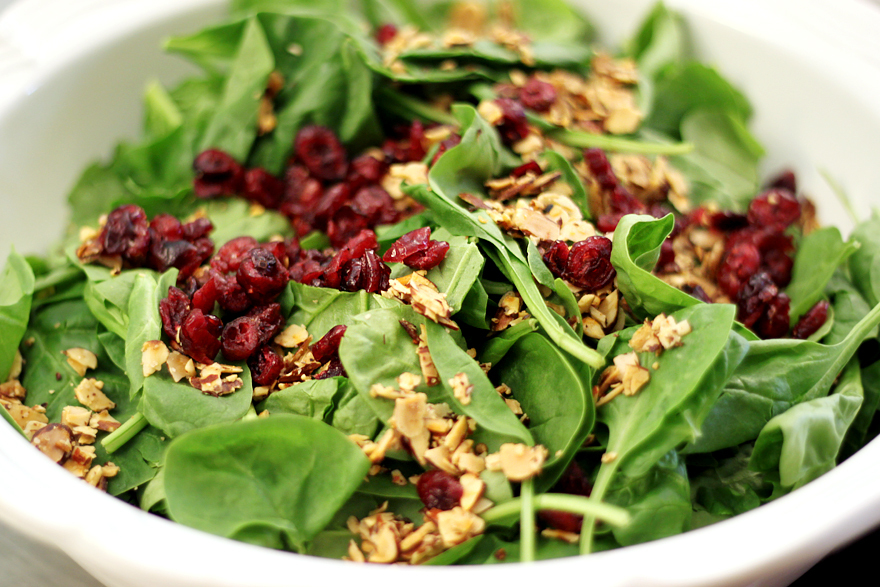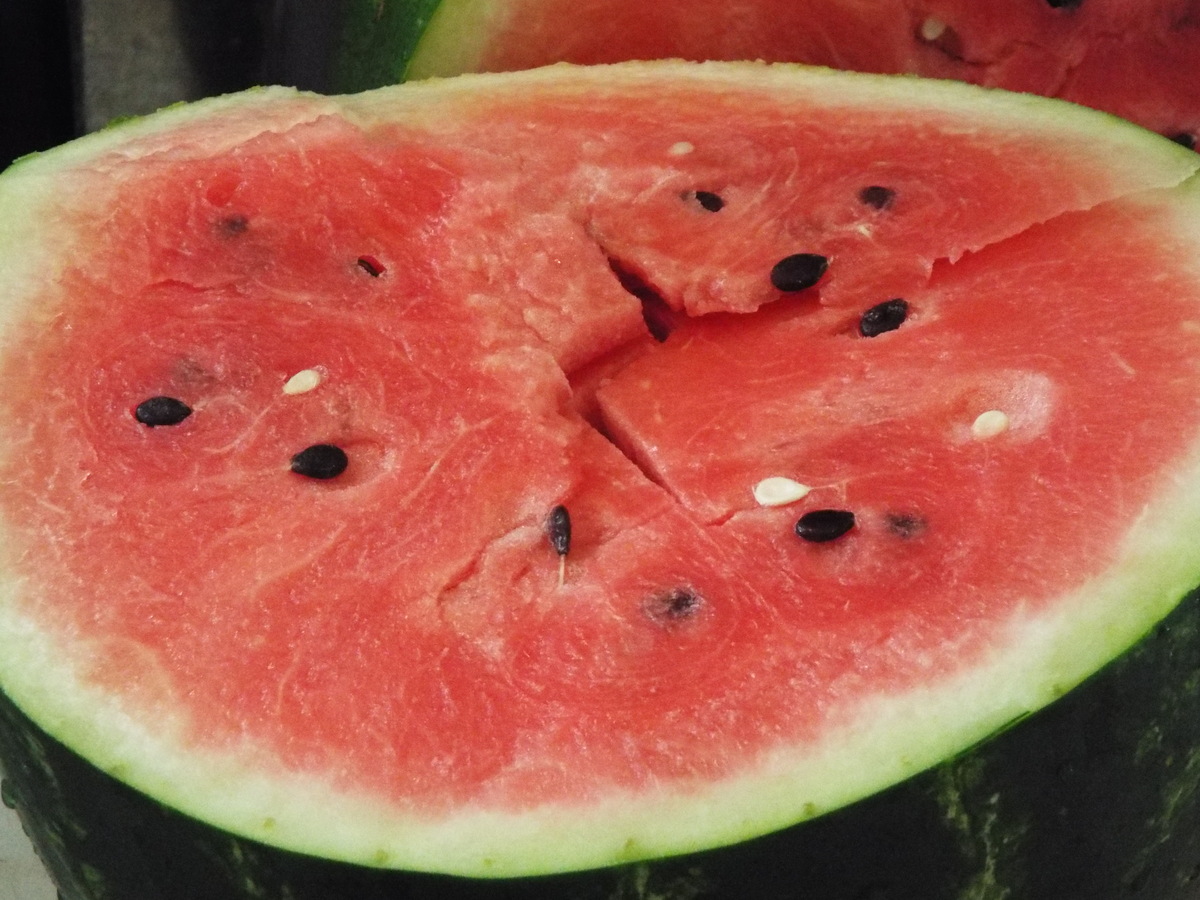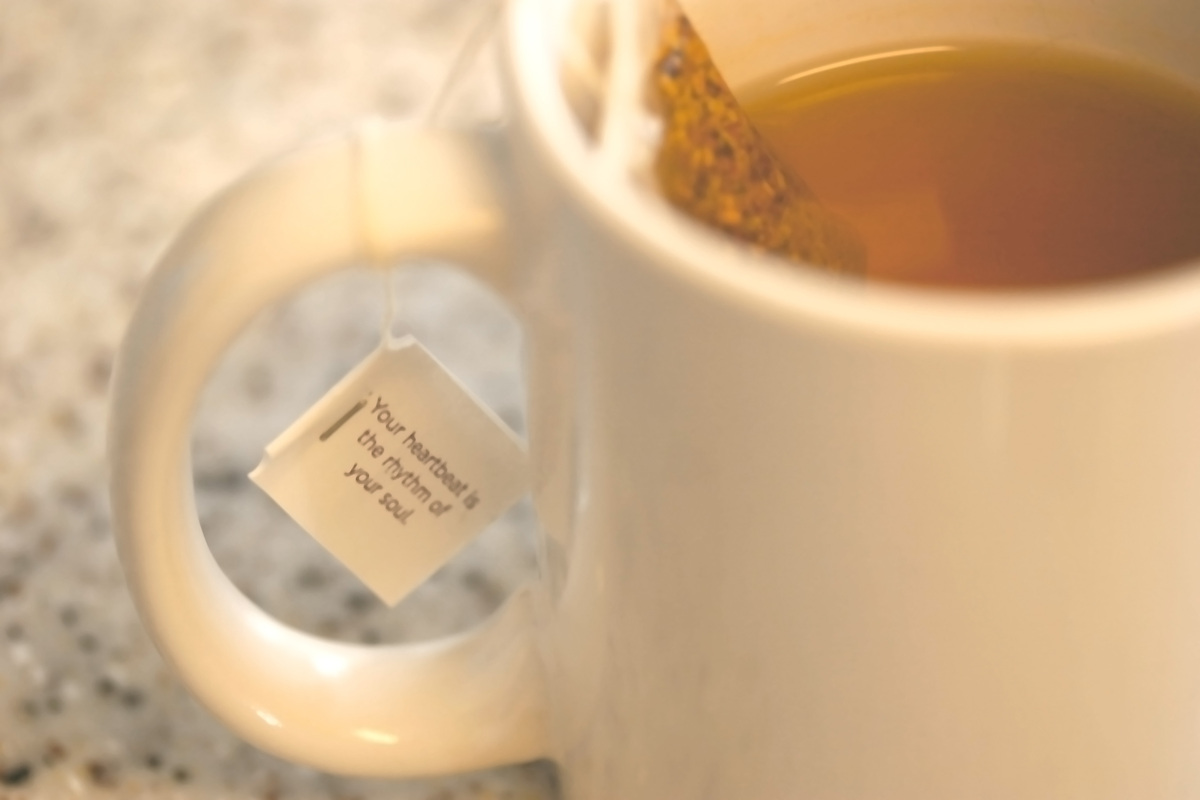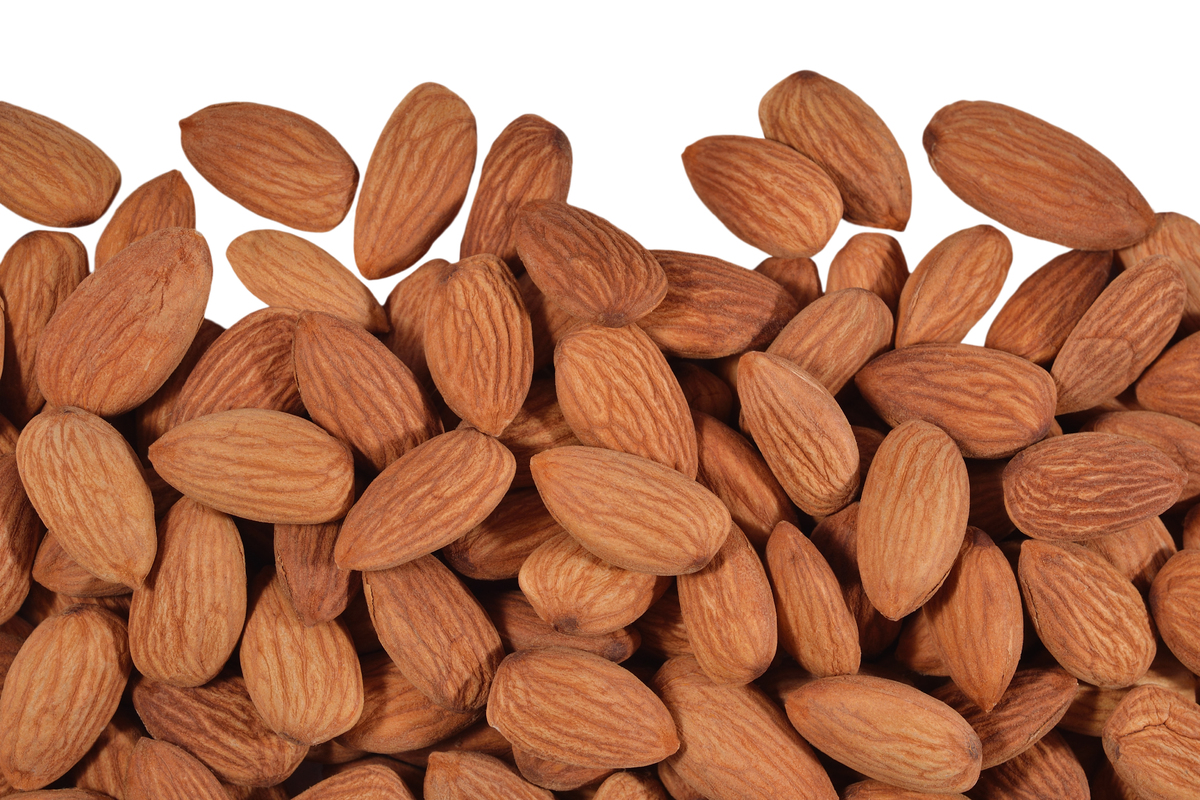Translate
-Disclaimer-
This is a personal blog. Any views or opinions represented
in this blog are personal and belong solely to the blog owner and do not
represent those of people, institutions or organizations that the owner may or
may not be associated with in professional or personal capacity, unless
explicitly stated. Any views or opinions are not intended to malign any
religion, ethnic group, club, organization, company, or individual.
All content provided on this blog is for informational
purposes only. The owner of this blog makes no representations as to the
accuracy or completeness of any information on this site or found by following
any link on this site. The owner will not be liable for any errors or omissions
in this information nor for the availability of this information. The owner
will not be liable for any losses, injuries, or damages from the display or use
of this information.
Photos
Unless stated, all photos are the work of NADHIRA AMALINA BINTI ADNAN and their respective owners. If used with watermark, no need to credit
to NADHIRA AMALINA BINTI ADNAN and their respective owners. For any edit to photos,
including cropping, please contact me first.
Videos
Unless stated, all videos are the work of NADHIRA AMALINA BINTI ADNAN and their respective owners. Please credit all videos to NADHIRA AMALINA BINTI ADNAN and link back to the original blog post.
Downloadable Files
Any downloadable file, including but not limited to pdfs,
docs, jpegs, pngs, is provided at the user’s own risk. The owner will not be
liable for any losses, injuries, or damages resulting from a corrupted or
damaged file.
Comments
Comments are welcome. However, the blog owner reserves the
right to edit or delete any Comments submitted to this blog without notice due
to
Comments deemed to be spam or questionable spam
Comments including profanity
Comments containing language or concepts that could be
deemed offensive
Comments containing hate speech, credible threats, or direct
attacks on an individual or group
This policy is subject to change at anytime.
The blog owner is not responsible for the content in
comments.
-Copyright-
© HEALTHY LIVING. Unauthorized use and /or duplication of
this material without express and written permission from this blog's author
and/or owner is strictly prohibited. Excerpts and links may be used, provided
that full and clear credit is given to HEALTHY LIVING and their respective
owners with appropriate and specific direction to the original content.
-Privacy Policy-
This blog does not share personal information with third
parties nor do we store any information about your visit to this blog other
than to analyze and optimize your content and reading experience through the
use of cookies. You can turn off the use of cookies at anytime by changing your
specific browser settings. We are not responsible for republished content from
this blog on other blogs or websites without our permission. This privacy
policy is subject to change without notice and was last updated on 6 MARCH
2014. If you have any questions feel free to contact me directly here: chentalynady@gmail.com
Lemons and Cancer: Is Lemon a Cancer Cure?
With an increase in reporting by major media outlets discussing the
many health benefits of various fruits and vegetables and how they play a
part in fighting disease, you may have already heard that lemons cure cancer. While this isn’t completely factual, there have been several studies that purport to show a strong basis in using lemons for cancer
treatment. It should also be noted that there are conflicting reports
detailing that, while lemons and other citrus fruits do contain
cancer-fighting properties, exactly how effective they are against
particular types of cancer has yet to be accurately determined.
Health Benefits of Lemons for Cancer
In addition to the Vitamin C found in lemon juice, which is already a very well known alternative cancer treatment
in its own right, the peel of the lemon also offers many health
benefits, one of the most important being that lemon peel can help to
eradicate toxins in your body. This may be why lemons for cancer are being studied and touted as a great remedy.
The connection between cancer and lemons isn’t something new; for decades, scientists have wondered, “Is lemon a cancer killer?” and have developed numerous studies to determine its validity.
Studies have revealed that lemon extract can successfully destroy
malignant cells in a wide range of cancers, including breast cancer,
colon cancer, and lung cancer. Several research studies also make the
claim that lemons can destroy cancer much more effectively than
chemotherapy, and in a safer and healthier manner. Additionally, the
studies also show that lemon extract therapy only affects malignant
cells, leaving healthy cells unharmed.
Additional health benefits of lemons include:
- It is antibacterial
- It is antiviral
- It aids in digestion
- It can be used to treat acne
- It helps to regulate blood pressure
- It fights against parasites and worms
- It possesses antidepressant qualities
- It helps to reduce stress and anxiety
Lemons for Cancer: How Much Do I Need to Consume?
So the question you may be asking yourself is, “Do lemons cure cancer
and how much lemon do I need to consume on a daily basis?” Before
answering this question, it must first be noted that while numerous
studies have shown effectiveness in the consumption of lemons as a cancer killer, and is still undergoing a variety of testing and research to even come close to making that assertion.
What is known is that specific compounds found in lemons (and other
citrus fruits such as oranges and grapefruit) known as flavonoids and
limonoids may either stop the formation and growth of cancer cells, or
will kill them outright. These studies have mainly been conducted on
animals and in laboratory conditions using human breast cancer cells.
In Europe, a study was conducted with participants afflicted with
various forms of cancer, in which they consumed 150 grams of citrus four
or more times a week. The citrus proved effective in decreasing the
risks of cancer by significant percentages, with the exception being
breast cancer. However, an American study did show a decrease in the
risk of breast cancer in participants using the same portions of
citrus—so long as they did not previously undergo hormone replacement
therapy.
When consuming citrus, it is also important to not just consume the
juice, but also the pulp and the peel, and even the seeds when possible.
Further research shows that 75 grams of citrus on a daily basis might
be the optimal minimum intake for those wishing to reduce the risks.
5 Strength Moves That Burn Fat Fast
The secret to slimming down isn't adding more cardio -- it's serious strength training! Rev up your metabolism and burn more calories around the clock with this muscle-making circuit.
How it works: Perform each exercise back-to-back, resting 30 to 45 seconds between moves as needed. Complete three circuits total.
You will need: Free weights, medicine ball
-
1) Med-Ball Plank 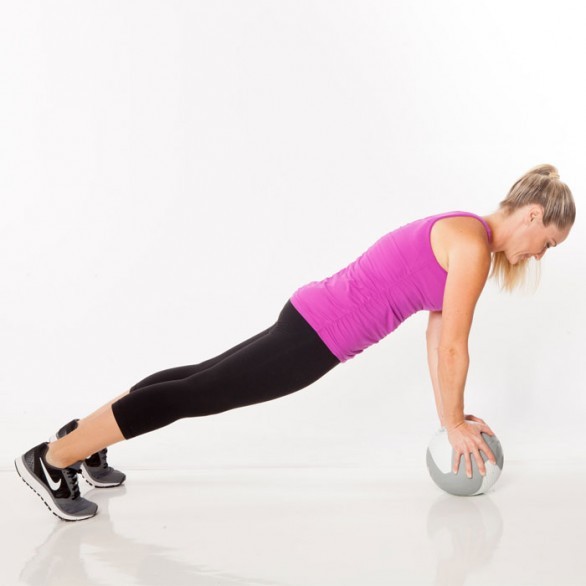 Vanessa Rogers Photography
Sets: 3
Vanessa Rogers Photography
Sets: 3
Reps: 45 seconds
Begin in plank position with hands balancing on top of a medicine ball. Keep abs drawn into spine and think about pressing chest away from the ball with strong arms as you hold the position. (Place feet wider apart to make the move easier; add a challenge by moving them closer together.) -
2) Long-Lunge Row  Vanessa Rogers Photography
Sets: 3
Vanessa Rogers Photography
Sets: 3
Reps: 10
A: Begin in a wide split stance with right leg forward and left heel lifted, both legs straight, holding dumbbells. Bend right knee, reaching dumbbells toward the floor on either side of right leg, hinging forward from hips and keeping spine naturally straight and abs engaged.
B: Extend right leg as arms row behind body, bending elbows and pulling weights in by sides and keeping torso slightly hinged forward (body should make a diagonal line from left heel to head). Complete the prescribed number of reps on each side. -
3) Pushup To Side Plank 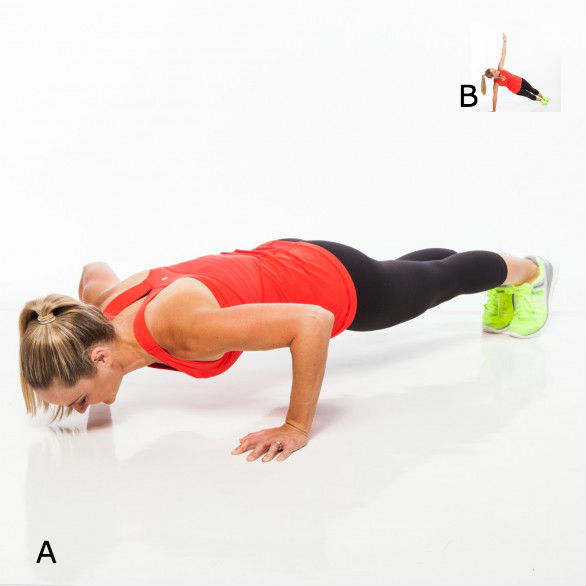 Vanessa Rogers Photography
Sets: 3
Vanessa Rogers Photography
Sets: 3
Reps: 10
A: Begin in pushup position with feet together, hands slightly wider than shoulders. Bend elbows, lowering chest as close to the floor as possible, maintaining a straight line from heels to head.
B: As arms extend, rotate body into a right side plank, drawing abs in tight, stacking hips and heels and reaching right arm up to ceiling. Return to pushup position and repeat, alternating sides. -
4) Alternating Press March 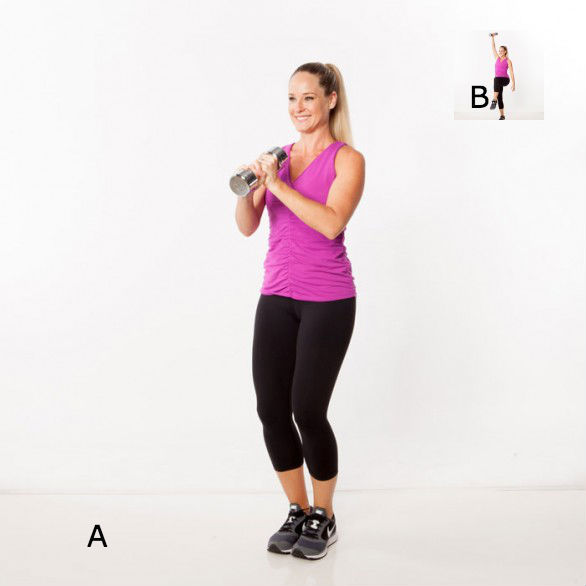 Vanessa Rogers Photography
Sets: 3
Vanessa Rogers Photography
Sets: 3
Reps: 20
A: Stand with feet together holding a dumbbell in front of chest with both hands.
B: Engage abs and grasp dumbbell with right hand, pressing right arm overhead as left knee lifts in front of hip and left arm lowers by side. Balance for one count, return to start. Repeat on opposite side. That's one rep. -
5) Med-Ball Slams 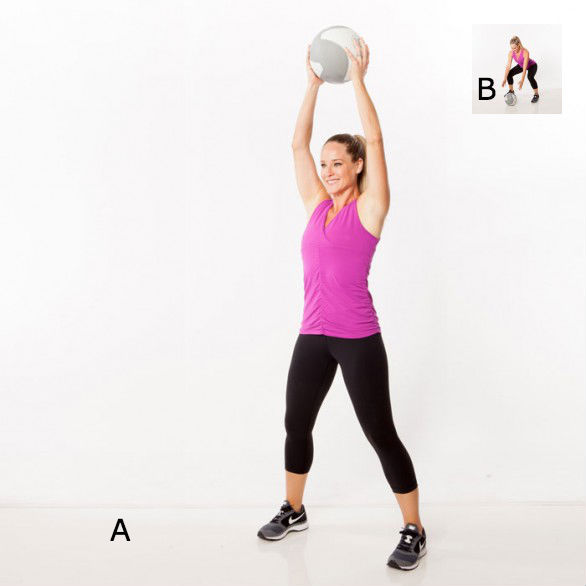 Vanessa Rogers Photography
Sets: 3
Vanessa Rogers Photography
Sets: 3
Reps: 10
A: Stand with feet wide holding a medicine ball. Engage abs and swing ball overhead in preparation for slam.
B: Explosively slam medicine ball to the floor, throwing the ball down and lowering into a squat. Try to catch the ball as it bounces back up, extending legs. Immediately return to start.
10 Best Cancer Fighting Foods For Your Health
Cancer is a wide group of diseases that involve unregulated
cell growth. This disease is also medically known as, malignant
neoplasm’. The body cells tend to divide and grow in an uncontrollable
manner forming several malignant tumors. However it should be noted that
not all tumors are cancerous. There are more than two hundred different
known cancers that affect human beings.
Therefore what are the causes of cancer? Well, the causes of this
disease are so numerous and diverse such that no any single human being
has ever comprehended. However, there are some few substances that are
known to increase the chances of one getting cancer for instance
tobacco, certain infections, exposure to radiation and obesity among
other things.
However if an individual constantly consumes the correct kinds of
food, then they may greatly reduce their chances of getting cancer. This
is actually the reason as to why there is the slogan, ‘Food, cancer,
health’. Health experts do encourage people to eat foods which are rich
in nutrients because of this.
Therefore, the following are just but some 10 best cancer fighting foods for your health;
Grape Fruits
Grape fruits are known to contain a lot of Vitamin C. On the other hand, Vitamin C is an antioxidant that may help prevent the formation of nitrogen compounds in the body. These compounds are always known to cause cancer. It has been medically proven that those who constantly consume grapes have very slim chances of getting cancer.
Grape fruits are known to contain a lot of Vitamin C. On the other hand, Vitamin C is an antioxidant that may help prevent the formation of nitrogen compounds in the body. These compounds are always known to cause cancer. It has been medically proven that those who constantly consume grapes have very slim chances of getting cancer.
Sweet Potatoes
Sweet potatoes are rich in substances such as Beta-carotene, Vitamin C, as well as fiber. Beta-carotene is also another powerful anti oxidant. Research shows that those who regularly consume foods that are rich in this anti oxidant have almost zero chances of getting stomach or any other type of cancer. Sweet potatoes are known to reduce the chances of one getting breast cancer by almost 50%.
Sweet potatoes are rich in substances such as Beta-carotene, Vitamin C, as well as fiber. Beta-carotene is also another powerful anti oxidant. Research shows that those who regularly consume foods that are rich in this anti oxidant have almost zero chances of getting stomach or any other type of cancer. Sweet potatoes are known to reduce the chances of one getting breast cancer by almost 50%.
Turmeric
Turmeric is rich in curcumin which is a very active ingredient. This ingredient tends to act as an anti oxidant as well as an anti-inflammatory. It may help the body to fight cancer by tampering with the aspects of cellular signaling. Turmeric can be found in curry powders, it is the yellow colored spice in these powders.
Turmeric is rich in curcumin which is a very active ingredient. This ingredient tends to act as an anti oxidant as well as an anti-inflammatory. It may help the body to fight cancer by tampering with the aspects of cellular signaling. Turmeric can be found in curry powders, it is the yellow colored spice in these powders.
Pomegranates
Pomegranates are very sweet fruits. These fruits are known to play a key role when it comes to the elimination of cancer in the body. They can deactivate the cancer causing substances and thereby preventing the growth of cancer cells. Pomegranates are readily available in the market.
Pomegranates are very sweet fruits. These fruits are known to play a key role when it comes to the elimination of cancer in the body. They can deactivate the cancer causing substances and thereby preventing the growth of cancer cells. Pomegranates are readily available in the market.
Berries
Berries are included in the list of the top 10 best cancer fighting foods. They contain antioxidants that are known to fight cancer. Berries also contain other natural chemicals which have cancer-fighting characteristics. Owing to this, it’s therefore advisable for you to regularly eat berry fruits like raspberries, blueberries among others.
Berries are included in the list of the top 10 best cancer fighting foods. They contain antioxidants that are known to fight cancer. Berries also contain other natural chemicals which have cancer-fighting characteristics. Owing to this, it’s therefore advisable for you to regularly eat berry fruits like raspberries, blueberries among others.
Ground Linseed
Linseed contains a lot of Omega-3 fatty acids. What is the importance of these acids to the body? Well, Omega-3 fatty acids can help prevent cancer by inhibiting cancer cell propagation. They are also known to interfere with the processes that may lead to the development of tumors. It’s therefore advisable for people to add Omega-3 rich foods to their diets, foods such as ground linseed among others.
Linseed contains a lot of Omega-3 fatty acids. What is the importance of these acids to the body? Well, Omega-3 fatty acids can help prevent cancer by inhibiting cancer cell propagation. They are also known to interfere with the processes that may lead to the development of tumors. It’s therefore advisable for people to add Omega-3 rich foods to their diets, foods such as ground linseed among others.
Tea
Tea is very rich in compounds known as, ‘catechins’. Scientists believe that this compound that is contained in tea may help inhibit the growth of cancer cells. It is also believed that catechins can help to stop cellular mutations that may lead to cancer development. Owing to this, people are always encouraged to drink tea regularly.
Tea is very rich in compounds known as, ‘catechins’. Scientists believe that this compound that is contained in tea may help inhibit the growth of cancer cells. It is also believed that catechins can help to stop cellular mutations that may lead to cancer development. Owing to this, people are always encouraged to drink tea regularly.
Cruciferous Vegetables
These are vegetables that belong in the family of cabbage. Cruciferous vegetables are rich in phytonutrients which are naturally occurring chemical compounds. These compounds are known to have more health benefits to the body, including that of fighting cancer. You may eat broccoli, cauliflower and cabbage among other foods for this.
These are vegetables that belong in the family of cabbage. Cruciferous vegetables are rich in phytonutrients which are naturally occurring chemical compounds. These compounds are known to have more health benefits to the body, including that of fighting cancer. You may eat broccoli, cauliflower and cabbage among other foods for this.
Wild Salmon
Recent studies are showing that people can get cancer due to lack of Vitamin D in the body. This is because Vitamin D does help stop the development of blood vessels that nutrify growing tumors. It can also help to inhibit the propagation of precancerous and cancerous cells. Among the foods that are rich in Vitamin D include wild salmon among others.
Recent studies are showing that people can get cancer due to lack of Vitamin D in the body. This is because Vitamin D does help stop the development of blood vessels that nutrify growing tumors. It can also help to inhibit the propagation of precancerous and cancerous cells. Among the foods that are rich in Vitamin D include wild salmon among others.
Peanuts
Peanuts contain Vitamin E supplements. On the other hand, studies are showing that foods that are rich in Vitamin E can help to reduce the risk of stomach, lung and other cancers. Owing to this, people are advised to add foods that are rich in Vitamin E to their diets, foods such as peanuts as well as peanut butter.
Peanuts contain Vitamin E supplements. On the other hand, studies are showing that foods that are rich in Vitamin E can help to reduce the risk of stomach, lung and other cancers. Owing to this, people are advised to add foods that are rich in Vitamin E to their diets, foods such as peanuts as well as peanut butter.
All in all, cancer is just a lifestyle disease that anybody can
prevent based on their eating habits. If you regularly consume the above
foods, then you are likely to stay safe from cancer. If you already
have it, then the above foods may also help you to get cured.
The Best Food For Headaches
Experts agree that knowing your triggers is one of the best ways to avoid the searing or pounding pain of a headache.
Triggers can be diet-related, and chronic headache sufferers often learn which eats and drinks are best for them to avoid. But if certain foods are off limits, are there also foods that help?
The evidence is less convincing, but there are a few potential pain-savers. The six foods below probably won't make a headache disappear completely, but they do seem to have preventive powers.
-
1) Spinach As if you needed another convincing reason to eat your greens, consider this: Those of the leafy variety are rich in riboflavin, a type of B vitamin that has been linked to preventing migraines. -
2) Fatty Fish 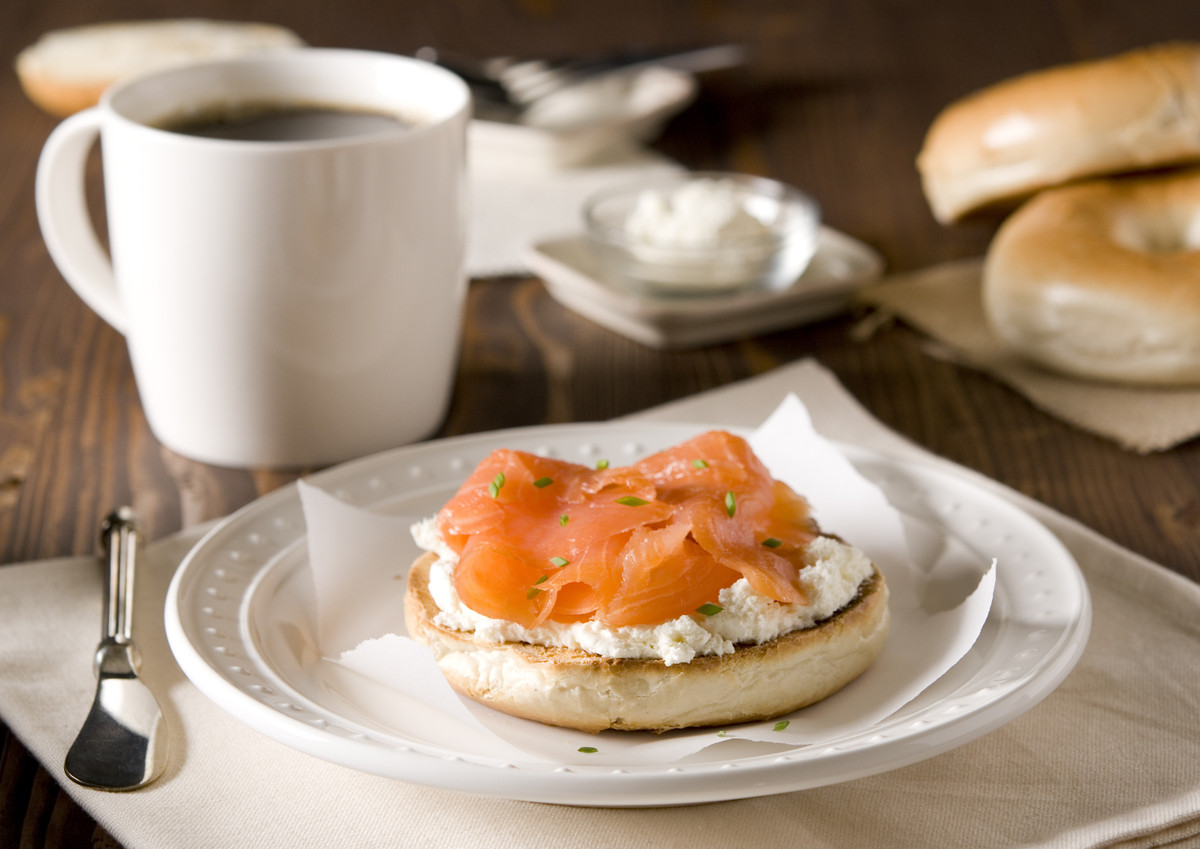 Getty Images
Those potent omega-3 fatty acids are at it again. Their anti-inflammatory properties can reduce the pain of chronic headaches, and the benefit is enhanced when dietary omega-6 fatty acids -- found in many food oils -- are simultaneously reduced, according to a 2013 study.
Getty Images
Those potent omega-3 fatty acids are at it again. Their anti-inflammatory properties can reduce the pain of chronic headaches, and the benefit is enhanced when dietary omega-6 fatty acids -- found in many food oils -- are simultaneously reduced, according to a 2013 study. -
3) Watermelon If your headache is dehydration-related, you're likely to reach for some H2O, stat. But foods with a sky-high water content like watermelon or cucumbers can also help. We get about 20 percent of our daily water intake from food, but watermelon also offers essential minerals you lose when you're dehydrated like magnesium and potassium. -
4) Potatoes 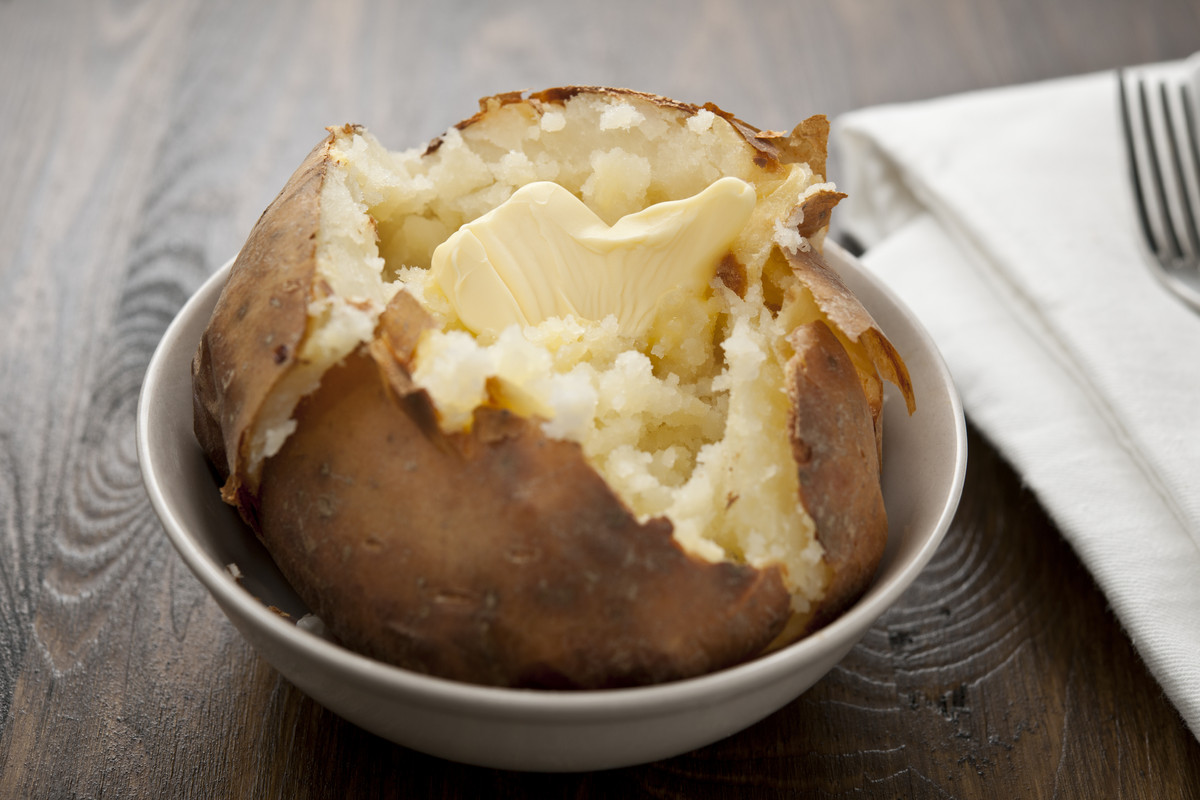 Getty Images
Speaking of potassium: The mineral can treat headaches, and we're often lacking when we're dehydrated. Despite the banana's high-potassium reputation, a medium baked spud (with the skin) packs 926 milligrams of the stuff, more than double what's found in a banana.
Getty Images
Speaking of potassium: The mineral can treat headaches, and we're often lacking when we're dehydrated. Despite the banana's high-potassium reputation, a medium baked spud (with the skin) packs 926 milligrams of the stuff, more than double what's found in a banana. -
5) Honorable Mention: Caffeine As long as you don't overdo it, caffeine may actually help headaches. Many headache medications contain a small dose, because it helps the body absorb those drugs faster, according to WebMD.
However, become too reliant on your tea or java and you risk rebound or withdrawal headaches when you come down from your caffeinated "high." These are likely if you're consuming 500 milligrams or more of caffeine a day, according to Everyday Health, about the equivalent of five cups of coffee. -
6) Honorable Mention: Almonds A small body of research has examined the importance of magnesium when it comes to treating migraines, without many concrete findings. The authors of a 2012 comment published in the Journal of Neural Transmission write that while magnesium seems to offer some potential in migraine prevention, there's little to suggest it would help mid-headache. Because it's relatively safe, they don't caution against it, but merely warn there's not enough evidence yet to assume all headache sufferers will benefit. Should you opt to go the magnesium route, almonds are a good bet, with 80 milligrams per serving.
Top 10 of Benefits of Aloe Vera
Different parts of the plant are used for different effects on the
body and Aloe Vera has both internal and external applications.
1. Aloe Vera Is High in Vitamins & Minerals:
Aloe Vera contains many vitamins including A, C, E, folic acid,
choline, B1, B2, B3 (niacin), B6. Aloe Vera is also one of the few
plants that contains vitamin B12.
Some of the 20 minerals found in Aloe Vera include: calcium,
magnesium, zinc, chromium, selenium, sodium, iron, potassium, copper,
manganese.
2. Aloe Vera is High in Amino Acids & Fatty Acids
Amino acids are the building blocks of protein. There are about 22
amino acids that are necessary for the human body and it is said that 8
of these are essential. Estimates of the amino acids found in aloe range
from 18-20 amino acids, with all 8 essential amino acids.
Alove Vera also includes quite an impressive range of fatty acids.
Aloe contains three plant sterols, which are important fatty acids- HCL
cholesterol (which lowers fats in the blood), campesterol, and
B-sitosterol. All are helpful in reducing symptoms of allergies and acid
indigestion. Other fatty acids include linoleic, linolenic, myristic,
caprylic, oleic, palmitic, and stearic.
3. Aloe Vera is an Adaptogen
Aloe Vera is a well-known adaptogen. An adaptogen is something that
boosts the body’s natural ability to adapt to external changes and
resist illness. It is thought that aloe’s power as an adaptogen balances
the body’s system, stimulating the defense and adaptive mechanisms of
the body. This allows you an increased ability to cope with stress
(physical, emotional and environmental stress like pollution)
4. Aloe Helps with Digestion
Poor digestion is related to many diseases. A properly functioning
digestive tract is one of the keys and foundations of health. Aloe is
known to soothe and cleanse the digestive tract and help improve
digestion. The interesting thing about taking aloe internally is that,
because it is an adaptogen, it helps with either constipation or
diarrhea, helping to regulate your elimination cycles in whatever way
you need. It’s been a great remedy for people with problems such as
irritable bowel syndrome as well as acid reflux. Aloe also helps to
decrease the amount of unfriendly bacteria and in our gut keeping your
healthy intestinal flora in balance. Aloe is also a vermifuge, which
means it helps to rid the body of intestinal worms.
5. Aloe Helps in Detoxification
Aloe Vera is a gelatinous plant food, just like seaweeds and chia.
The main benefit to consuming gelatinous plant foods in your diet is
that these gels move through the intestinal tract absorbing toxins along
the way and get eliminated through the colon. This will help the proper
elimination of waste from your body and help the detoxification of your
body.
6. Aloe Alkalizes the Body
Disease cannot manifest in an alkaline environment. Most people are
living and subsisting on mostly acidic foods. For great health, remember
the 80/20 rule – 80% alkaline forming foods and 20% acidic. Aloe vera
is an alkaline forming food. It alkalizes the body, helping to balance
overly acidic dietary habits
7. Cardiovascular Health
There hasn’t been a lot of studies conducted in this but there has
been some research to show that Aloe Vera extract injected into the
blood, greatly multiplies the oxygen transportation and diffusion
capabilities of the red blood cells.
According to a study published in the 2000 issue of the British
Medical Journal, beta sitosterol helps to lower cholesterol. By
regulating blood pressure, improving circulation and oxidation of the
blood, lowering cholesterol, and making blood less sticky, Aloe Vera
juice may be able to help lower the risk of heart disease.
8. Aloe Helps Boost the Immune System
I think given the stresses of our daily lives, every one can use a
boost to their immune systems. The polysaccharides in aloe vera juice
stimulate macrophages, which are the white blood cells of your immune
system that fight against viruses.
Aloe is also an immune enhancer because of its high level of
anti-oxidants, which help combat the unstable compounds known as
free-radicals, contributing to the aging process. (Free radicals are a
bi-product of life itself, it is a naturally occurring process but we
can overload ourselves with unnecessary free-radicals by living an
unhealthy lifestyle) Aloe is also an antipyretic which means it used to reduce or prevent fever.
9. Aloe Vera is Great for the Skin
Because of aloe’s well-known healing properties for the skin, aloe is
one of the primary compounds used in the cosmetic industry. It is a
known vulnerary, (meaning it helps heal wounds) and is great for
applying topically to burns, abrasions, psoriasis and even to bug bites.
Aloe acts as an analgesic, acting to help relieve pain of wounds. It’s
feels especially good to cut a stem of aloe, place it in the fridge and
rub it on sun burnt skin – the immediate soothing effect feels like an
absolute lifesaver. Aloe is also an antipruritic: A substance that
relieves or prevents itching. Aloe Vera is an astringent: which causes
the contraction of body tissues, typically used to reduce bleeding from
minor abrasions.
10. Disinfectant, Anti-biotic, Anti-microbial, Germicidal, Anti-bacterial, Anti-septic, Anti-fungal & Anti-viral:
Wow, I think that covers all anti- bases. Okay, I admit, that was
just a sneaky way to add in another 8 good reasons why you should keep
Aloe Vera handy and incorporate it into your lifestyle. Aloe Vera’s
active ingredients are sulphur, lupeol, salicylic acid, cinnamic acid,
urea nitrogen and phenol which are substances that prevent the growth of
disease-causing microorganisms and act as a team to provide
antimicrobial activity thus eliminating many internal and external
infections, also active against bacteria. It also helps to treat fungal
and viral infections.
Best Way To Get Rid Of Acne Fast, Safe, and Effective in 2014!
Even though people often associate acne with teenagers, adults well
into their 30s, 40s, possibly even their 50s may have problems with
acne. Not only does acne look unattractive, but most of the time it will
eventually go away. However, another to reason to get rid of acne as
quickly as possible is that it might leave our skin prone to scarring,
which unlike the acne itself is not going to go away. Many people find
that they have lowered self-confidence when struggling with acne and
feel as though they are unattractive.
What is acne exactly?
There are small oil-producing glands called sebum inside our hair
follicles. This oil mixes with skin cells inside of the follicle and
they travel outwards onto the surface of our skin together. If there is
something on the surface that will block the exit from the follicle, too
many dead skin cells, or too much sebum, a blockage might happen.
Bacteria then join the fray and this leads to the most common form of
acne – acne vulgaris.
Some general tips on how to get rid of acne
Even though these tips are not necessarily going to prevent an acne outbreak, they may present the best way to get rid of acne in that it can help to avoid making it worse:- Avoid touching your face – This sounds easy for most people until they realize how often they touch their own face. They scratch their ears, wipe their lips, and relieve itches when they occur. If you paid attention to how many times you touch your face during a normal day, you might be surprised. Oil, grime, and sweat all spread across surfaces that we interact with daily. By not actively touching your face, you are avoiding the transfer of bacteria which helps reduce problems with acne.
- Washing your face twice a day – Perhaps the best way to get rid of acne is to stop the buildup of grease and grime altogether. Washing your face two times a day will help, but doing it more than that might strip away the essential oils. Use a mild soap or cleanser, warm water, and a clean washcloth.
- Check your makeup – Countless people wash their face to avoid acne but actively give themselves more acne problems by using makeup that causes blemishes. For many people, the best way to get rid of acne is by examining what they are putting on their face themselves and seeing whether it is hurting their appearance.
Use benzoyl peroxide
One
of the most common ways to get rid of acne is by using benzoyl
peroxide. Even though cleansers or lotions are available in prescription
versions, you can get benzoyl peroxide products over the counter
without any problem. Using benzoyl peroxide can help kill the bacteria
responsible for the inflammation. It is important to be patient when
using benzoyl peroxide because it can take upwards of three weeks before
you notice any results.
Why salicylic acid can help?
Many people wonder why we would put salicylic acid in an article that
explores the best way to get rid of acne. Because it does not have any
effect upon sebum production nor does salicylic acid kill bacteria.
However, it does remove the outermost layer of the skin, which means
that blockages are not a serious problem anymore. Unfortunately, because
it removes the outer layer it is not a good idea to use this on a skin
with sores or cuts or even irritated or sensitive skin.
Isotretinoin
Even if you have never heard of isotretinoin, you might have heard of
the brand name Accutane. Even though the exact workings of isotretinoin
are unknown, experts believe that it has something to do with the
dramatic reduction of sebum production. One of the problems is that it
can take a long time before the product finally starts to work, because
many patients may not see any significant changes until four or five
months after they start using the treatment. Unfortunately, some of the
side effects are scary as well.
Antibiotics could be next.
If you find that your over the counter treatments
are not the best way to get rid of acne, you may have to try something a
little stronger and use antibiotics. At their most basic, these destroy
or damage bacteria, which means that it would logically reduce the
infection in the pores. It prevents future bacterial growth (providing
that you keep using it) while reducing existing inflammation. However,
they make your skin sensitive to light and may cause dryness or scaling.
Finally, doctors are often hesitant to keep a patient on antibiotics
for a long period of time.
Best Way To Get Rid Of Acne – Cheap Home Remedies For You
Especially when dealing with light acne, the best way to get rid of acne might be to try a home remedy. Even though they might not always be as effective as commercial products, they are still worth a shot:- Oatmeal mask – The oatmeal will dry and exfoliate your skin and the honey is going to tone the skin. Apply the mixture to your face and leave on for about 15 minutes.
- Honey and cinnamon – A paste of three tablespoons honey and one tablespoon of cinnamon applied directly to the acne before heading to bed might help. Repeat this nightly before you head to bed for about two weeks.
- Papaya – the papain enzyme in this fruit is a powerful treatment for acne and quickens healing time for superficial wounds. Mash the papaya into a thick paste and apply it to the parts of your skin that need it. This can help remove lipids from your skin before they have a chance to clog the pores, thus preventing future outbreaks.
Best Way To Get Rid Of Acne – A New Approach To Acne Treatment
Sometimes people say that ‘we save the best for last,’ which is what we did with this particular article. We wanted to take this moment to discuss what might possibly be the best way to get rid of acne, by using science and nature together to approach the entire spectrum of acne problems – Exposed Skin Care.
Exposed
Skin Care acne treatment gel helps clear up acne that you already have,
prevents the formation of new acne, but also helps reduce any possible
acne scars and evens the skin tone. This makes it a tremendous
breakthrough in the way that it addresses all the different issues with
acne.
Considering that the product is gentle enough to use on sensitive
skin, and you might understand why this is something to be excited about
if you have ever struggled with acne. If you have never tried the
Exposed Skin Care acne treatment gel before, it is highly recommended
that you try it. Considering that it is currently on an introductory
sale for 40% off and comes with a one-year money back guarantee, you
have nothing to lose but unattractive acne.
Make Your Resolutions Stick
Don't set yourself up to feel like a days fitness failure by
setting unrealistic, impractical or boring workout resolutions. Instead,
follow these surefire tips to keep your days resolutions and
reach your fitness goals.
Make a short list
You can't reach goals unless you set them — but you won't reach your
fitness goals if you set too many or make them too vague. It's wiser to
make a list of three to five fitness goals instead of a long impractical
list or one unspecific goal, such as "work out more." A short list will
make your fitness resolutions less overwhelming and more achievable.
Here's an example of a short list of fitness resolutions:
- Do 20 minutes of cardio three days a week (you can even specify the days to make you more accountable).
- Take the kettlebell class at the gym on Mondays and Thursdays (insert any class here).
- Try one new workout every two weeks (this can be a new fitness class, a fitness DVD or a session with a personal trainer).
Know your limits, but don't be limited
Reach for your dreams, but don't set the bar so high that you crash
and burn. At the beginning of the year, you are super-amped to set goals
and meet them, but your enthusiasm might wane once you encounter
limitations caused by work, family, illness or fitness level. Instead of
making a fitness resolution to run a marathon by spring, work your way
up a big accomplishment. For example, make a fitness goal to run a 5K;
once you do, make another fitness goal to run a 10K. Then, shoot for a
half-marathon and then, a marathon. You may not run a marathon by
spring, but you will be training for longer-distance events and meeting
fitness goals along the way, which is key to staying motivated.
Exercise and enjoy it
Don't resolve to join the Zumba team if you hate dancing. Just
because a workout is the new rage does not mean you must labor through
it if you hate it. Determine the activities you like doing and make
fitness resolutions to get more of them. Do try new workouts — we
recommend once a week — to add variety to your routine, but if you know a
certain mode of exercise isn't for you, don't force it. The more
enjoyable your physical activities, the more likely you'll do them.
Be flexible
In a perfect world, you'd make an exercise schedule, and nothing
would get in the way of your daily workout. We don't live in a perfect
world, though, so prepare for scheduling snafus, whether it's your boss
calling a lunch meeting that keeps you from your noontime boot camp
class, or you sleeping through your 6 a.m. alarm and having no time to
run before taking your kids to school. Always have a backup workout
plan, and don't stress about it. Fitness DVDs are the perfect substitute
for class workouts, and they can be done whenever your schedule allows.
Another option is to simply take a powerwalk when you get a break in
your day and commit to getting back on your planned week of workouts.
Being flexible will keep you from giving up and feeling like a fitness
failure.
Plan for your workouts
Pull out your smartphone and put your workouts on your calendar.
Being able to see them every week keeps you accountable. Consider it an
exercise to-do list; you know how good it feels to check things off a
list. In addition to scheduling your workouts, make it easy to do them.
Lay your fitness attire out the night before your workout, set an alarm
if you're doing early-morning exercise, and pack your gym bag with a
bottle of water, nutrition bar, towel and anything else you'll need
before and after you sweat.
Dress the part
Think about it: Are you going to be more motivated to go to the gym
clad in your baggy sweats or in cute leggings and a tank top? Buy one or
two flattering fitness outfits that you can mix and match. You'll feel
better about yourself — and when you look in the mirror while you sweat,
you'll know you look better, too.
Subscribe to:
Comments (Atom)


